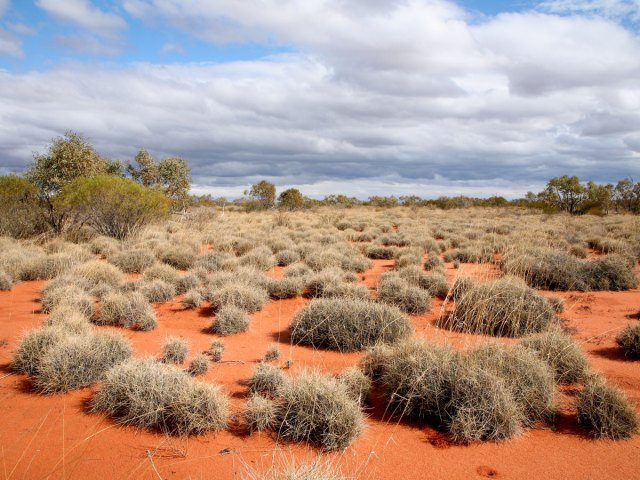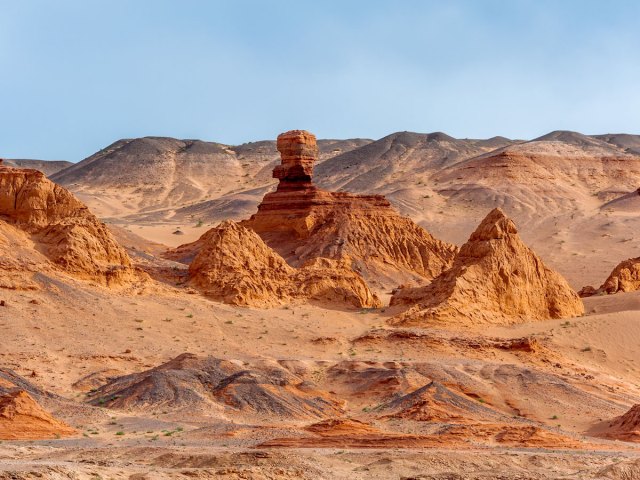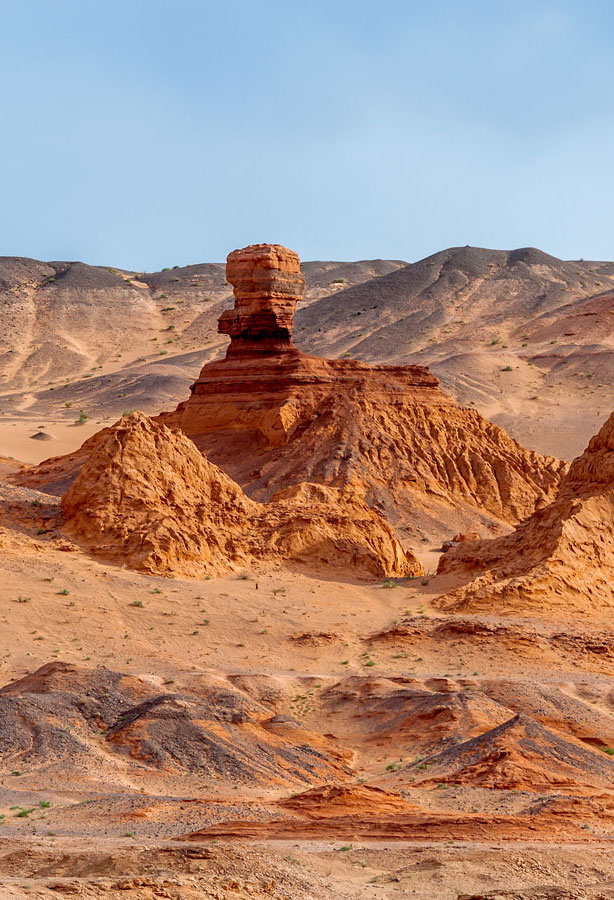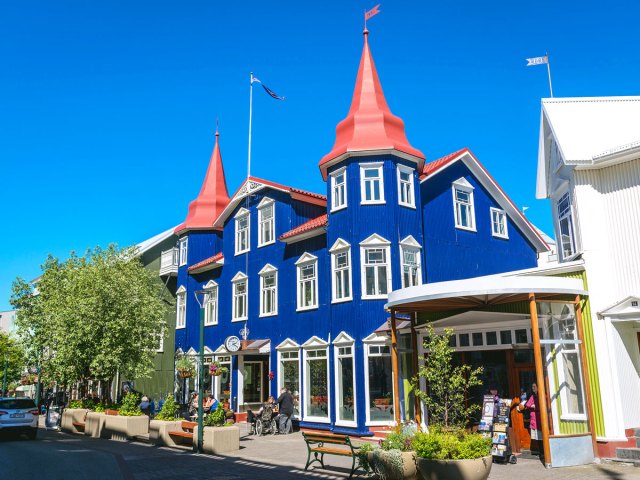Deserts cover around one-third of Earth’s land surface area. These geographical regions are defined by arid climates where one-of-a-kind ecosystems thrive. While the typical image of a desert is often a vast area of sand and rolling dunes with free-roaming camels, there are in fact five types of desert: subtropical, coastal, rain shadow, interior, and polar deserts. Wondering which of Earth’s deserts are the largest? Read on to discover just how vast the 10 largest deserts in the world are.
10. Great Basin Desert – Nevada and Utah (190,000 Square Miles)

Mainly located in Nevada and Utah, the Great Basin Desert is the largest of North America’s four deserts. This cold desert is framed by the lofty, snow-capped peaks of the Sierra Nevada and Rocky mountain ranges. Within its vast area of nearly 200,000 square miles, the desert contains numerous striking geological formations, from salt flats to ancient lake beds. The Great Basin Desert is also home to many unique flora and fauna, including the bristlecone pine, the Great Basin sagebrush, and the desert tortoise. Within the desert is Great Basin National Park, which attracts visitors with opportunities for stargazing, hiking to the summit of 13,063-feet Wheeler Peak, and discovering stalactites and stalagmites within the Lehman Caves.
9. Rub’ al-Khali – Arabian Peninsula (250,000 Square Miles)

Sprawling across parts of Saudi Arabia, Oman, Yemen, and the UAE on the Arabian Peninsula, Rub’ al-Khali is characterized by enormous, shifting dunes. This is the largest area of continuous sand in the world and also one of Earth’s driest places. Often called the “Empty Quarter,” Rub’ al-Khali is virtually uninhabited and, for the most part, remains unexplored. The Indigenous Bedouin peoples have historically traversed the dunes in search of riches, although there’s no permanent human settlements. (That said, according to legend, there is a buried lost city called “Atlantis of the Sand.”) Visitors to Rub’ al-Khali can camp beneath the stars in complete solitude and live out scenes captured in movies such as 2015’s Star Wars: The Force Awakens, which was filmed here.
8. Great Victoria Desert – Australia (250,000 Square Miles)

The Great Victoria Desert stretches across the states of Western Australia and South Australia with a landscape of sand dunes, shrublands, and acacia and eucalyptus woodlands. For millennia, this has been the sacred lands of Indigenous Australian groups such as the Pintupi and Pitjantjatjara. British-born Australian explorer Ernest Giles visited the area in 1875 and named it after Queen Victoria.
The arid region provides a natural habitat for over 100 species of reptiles, including geckos, goannas, and elapid snakes. The desert also shelters nine endangered plant species, 10 threatened mammals, and four threatened bird species. A popular route through the Great Victoria Desert travels from the town of Leonora along the Great Central Road to the famous Uluru rock formation (formerly called Ayers Rock).
7. Patagonian Desert – Argentina (260,000 Square Miles)

Occupying almost the entire southern portion of mainland Argentina, the Patagonian Desert is a semi-arid steppe and desert. It’s bordered by the majestic Andes mountains to the west and the Atlantic Ocean to the east. Topographically diverse, the desert is made up of everything from tablelands and canyons to river valleys, forests, and glacial lakes. They provide habitats for varied wildlife such as birds of prey, desert iguanas, guanacos, and Patagonian gray foxes. Trekking and glacier walking in Los Glaciares National Park are popular activities in the desert, as are boat tours and rafting in Nahuel Huapi National Park.
6. Kalahari Desert – Southern Africa (360,000 Square Miles)

One of two African deserts to make the list, the Kalahari Desert is a far-reaching sandy savannah that stretches south from Angola through sections of Namibia, Botswana, and South Africa. Comprising the largest ecosystem in Botswana, the Kalahari Desert is fed by the waters of the Okavango Delta, the world’s largest inland delta. The San (Bushmen), who have called the desert home for over 20,000 years, are Indigenous hunter-gatherer peoples who are thought to be the oldest residents of southern Africa.
Today, visitors to the Kalahari Desert come for the chance to spot majestic animal species, including lions, cheetahs, elephants, onyx, and gemsbok. Among the best places to do so are Botswana’s Central Kalahari Game Reserve and South Africa’s Kgalagadi Transfrontier Park.
5. Gobi Desert – China and Mongolia (500,000 Square Miles)

Asia’s second-largest desert straddles the border of Mongolia and northeastern China. This rain shadow desert sits between the Himalayas and icy Siberian steppes and is made up of a predominately rocky landscape. Only around 5% of the desert is sand, although this includes the Khongor Sand Dunes, which reach up to 260 feet tall and 112 miles long. Historically, the region was the location for important stops on the ancient Silk Road. It’s also scattered with religious monuments such as the Mogao Caves in Dunhuang, China — a UNESCO-protected Buddhist complex featuring almost 500 cave temples and thousands of murals. Another notable site within the desert is Mongolia’s Flaming Cliffs, where some of the first fossil dinosaur eggs were discovered in the 1920s.
4. Arabian Desert – Middle East (900,000 Square Miles)

The mystical Arabian Desert stretches all the way from Iraq to Yemen and the Persian Gulf, with the largest section lying within Saudi Arabia. Known for extreme temperatures, it boasts a dramatic landscape of golden sands, salt flats, limestone cliffs, and mountains. Amid this inhospitable region, acacia trees, date palms, roses, and other plant species thrive. Wildlife includes gazelles, oryx, sand cobras, and migratory birds. A cradle for Arabian culture, the desert is a fascinating showcase of the old and new. Jordan’s ancient carved-rock city of Petra and the modern metropolis of Dubai are two places where this contrast is most visible.
3. Sahara Desert – Northern Africa (3.32 Million Square Miles)

The Sahara Desert is the world’s largest hot desert. This subtropical desert extends into 10 African countries situated between the Red Sea and the Atlantic Ocean. The Bedouin, Berber, and Tuareg peoples also live within the sand dunes, savannahs, and rocky plateaus of the region. Some 500 plant and 70 mammal species flourish here, including the Sahara’s emblematic camels and desert foxes. Visitor highlights include Egypt’s 13th-century Shali Fortress and White Desert National Park, Chad’s Zakouma National Park, and Morocco’s Todra Gorge.
2. Arctic Polar Desert – Arctic Circle (5.3 Million Square Miles)

The world’s second-largest desert is one of only two polar deserts located on the planet. Cold, windy, and unforgiving, the Arctic Desert spreads over three continents and eight countries: Canada, Greenland, Iceland, Norway, Sweden, Finland, and Russia. While snow is found here, it very rarely melts thanks to the region’s extremely low temperatures.
Despite this, roughly 1,700 plant species thrive in the Arctic tundra. They are typically short root plants, which is why trees are uncommon. Animal species include the Arctic fox and wolf, caribou, polar bear, and snowy owl. If they can make the trek, travelers will find plenty of highlights throughout this polar region — Canada’s Ellesmere Island, Greenland’s Northeast Greenland National Park, and Norway’s Lofoten archipelago are all found here.
1. Antarctic Polar Desert – Antarctica (5.39 Million Square Miles)

The Antarctic Polar Desert covers the entire continent of Antarctica. Among Earth’s coldest, driest, and windiest locations, the desert also encompasses the South Pole. There’s no rain or snow here, but there are iceberg-flanked passageways and endless miles of thick ice sheets, some of which reach heights of over 13,000 feet.
The region is also known for peaks called nunataks, which rise above ice sheets. The desert’s McMurdo Dry Valley is the only recognized place in the world devoid of microbial life. While the Antarctic Polar Desert may be extremely remote, it’s still possible to visit: A popular excursion sets sail from Ushuaia, Argentina, on a journey via the infamous Drake Passage.
More from our network
Daily Passport is part of Optimism, which publishes content that uplifts, informs, and inspires.























